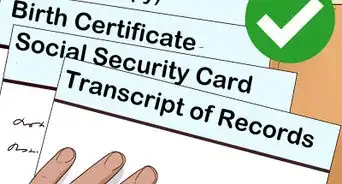This article was co-authored by wikiHow Staff. Our trained team of editors and researchers validate articles for accuracy and comprehensiveness. wikiHow's Content Management Team carefully monitors the work from our editorial staff to ensure that each article is backed by trusted research and meets our high quality standards.
There are 14 references cited in this article, which can be found at the bottom of the page.
wikiHow marks an article as reader-approved once it receives enough positive feedback. In this case, 93% of readers who voted found the article helpful, earning it our reader-approved status.
This article has been viewed 294,380 times.
Learn more...
Being a foreign exchange student will enhance your life for years to come as you broaden your outlook and learn more about other cultures. The word “exchange” is a bit of misnomer, however, as there need not be a one-for-one exchange.[1] If you’re truly interested in foreign exchange, start your research process early, check off all blocks, and you should have a wonderful experience abroad.
Steps
Researching Your Program Options
-
1Be certain you’d like to be a foreign exchange student. If all you want to do is learn a foreign language, sign up for a foreign language class. Being abroad has much more to do with culture and experience than simply language skills. Reaffirm your intentions by listing the positives and negatives of being a foreign exchange student.[2]
-
2Choose a foreign exchange program. There are many great exchange programs out there. Look at the web page for Council On Standards For International Educational Travel (CSIET) to get a reputable list. Programs are organized based upon a commitment to universally accepted higher standards.A few to consider are:Advertisement
-
3Consider the cost of a foreign exchange student. It can be very costly, and budgeting will become very important. Aside from the costs related to the foreign exchange service that you use, travel costs and living expenses can add up, possibly near $10,000.[6]
- A general recommendation of allotting yourself a few hundred dollars per month is not uncommon.[7]
- Applying for a scholarship or working a part-time job are good ways to offset the costs.
- Health insurance while abroad as a foreign exchange student can be pricey. Depending on where you are planning on studying abroad, it’s mandatory.[8]
-
4Talk to other foreign exchange students. Look for people who have been exchange students before and ask them general questions about it. You should ask several questions to gauge their experiences and opinions, then weigh the answers into your decision.
- Where and when they were exchange students
- Why they decided to be exchange students
- Which foreign exchange organization they used, and whether they recommend that service
- What were the biggest benefits they got from being an exchange student
Selecting and Preparing for Your Host Country
-
1Identify your ideal host country. While some programs make no promises about the exchange destination, it’s still worth selecting the country you’d like to visit. Isolating the country can help prepare you for the various paperwork, financial obligations, educational requirements, and language hurdles.
-
2Learn the basics of your future host country language. The language requirements vary depending on your destination and on the program you're applying to. In some situations you may need to be fluent to survive, while in others just the language basics will be sufficient to get you started. While the expectation is language skills will improve abroad because of complete immersion, there will still need to be some understanding of the host language.
- In general, one year or foreign language study in high school, or an intensive summer program, is required for preparation. [9]
- Practice the language with a pen-pal. Locate a pen-pal from your future host country. In years past, foreign pen pals were much more difficult to find. Now it’s just a matter of registering for any number of pen-pal websites, searching a database, and initiating correspondence.
-
3Determine if your desired host country accepts your education level. Different countries have different study and live abroad options open to high school and college students. Research if where you’d like to live accepts your age group and/or scholastic level.
- Study abroad while in high school may be a bigger transition than in college, with more language and social difficulties.[10]
-
4Apply for a passport and visa as necessary. Some countries you may go to will require a passport, and others will require both a passport and visa. It may also depend on your country of origin and its political affiliation with a potential host country. You’ll need to view a government-sponsored website that lists specific requirements when visiting foreign countries.[11]
- Be aware the some countries require submission of paperwork or travel to their specific consulate in order to receive appropriate passport and visa stamps.[12]
- Note that some countries have visa requirements based upon the length of time you intend to stay in their country.
Applying to Be a Foreign Exchange Student
-
1Register and apply for your desired program. Generally applying for foreign exchange programs are not difficult. Most student exchange programs require basic information like name, sex, desired country, age, address, phone number, email, and nearest international airport.[13] There may also be a deadline for your submission.[14]
- Fall semester deadlines are generally around the end of April.
- Spring semester deadlines are generally around the end of October.
- Visit the program's website, Facebook page, or otherwise ensure the registration deadlines.
-
2Provide language proficiency scores. Most application processes will require some form of proof that you’re capable of basic communication in your future host country. In some countries, there may be a general language certification. In other countries, the following types of tests and measurement requirements are mandatory: [15]
- The Standards-based Measurement of Proficiency (STAMP) test was originally developed at the University of Oregon and measures skills like reading and speaking in nine different languages.
- The Test of English as a Foreign Language (TOEFL) is a worldwide recognized test that measures English proficiency, and is widely used at the college and university level.[16]
-
3Submit supporting documentation. Many programs require information that supplements your language proficiency. Aside from proving you have the appropriate passport and visa, you may also have to provide an additional passport photo, your scholastic transcripts, and a curriculum vitae (CV) among other documents.
-
4Participate in orientation. Most programs have an orientation before you leave. It may be at the business location or at your home. Afterwards, a follow-up orientation is often conducted once you arrive at your host country. Both orientations are beneficial for the final details and questions that make everything function smoothly.[17]
Community Q&A
-
QuestionHow can I become an exchange student to a Japanese high school?
 Community AnswerTry applying with a foreign exchange program, such as AFS.
Community AnswerTry applying with a foreign exchange program, such as AFS. -
QuestionHow can I be a foreign exchange student if no one will help me?
 Community AnswerTry talking to a principal or guidance counselor at your school.
Community AnswerTry talking to a principal or guidance counselor at your school. -
QuestionWhat grades do I need to have to become a foreign exchange student?
 Community AnswerThe minimum you can have is a 2.8 GPA. You can’t fail any classes, but the higher your GPA is, the better.
Community AnswerThe minimum you can have is a 2.8 GPA. You can’t fail any classes, but the higher your GPA is, the better.
Warnings
- You need to be very flexible and adjustable.⧼thumbs_response⧽
References
- ↑ https://exchanges.state.gov/us/commonly-asked-questions-0
- ↑ http://exchangestudentworld.com/student/become-an-exchange-student/
- ↑ www.rotary.org
- ↑ www.yfu-usa.org
- ↑ http://www.icesusa.org/
- ↑ http://exchangestudentworld.com/student/costs/
- ↑ https://efexchangeyear.org/guide/posts/expenses/
- ↑ https://www.insubuy.com/international-student-health-insurance-usa/
- ↑ https://www.educationcorner.com/guide-foreign-exchange-students.html
- ↑ https://www.educationcorner.com/guide-foreign-exchange-students.html
- ↑ https://travel.state.gov/content/passports/en/country.html
- ↑ http://www.nwse.com/become-an-exchange-student/faq/
- ↑ http://www.nwse.com/become-an-exchange-student/registration/
- ↑ http://www.nwse.com/become-an-exchange-student/faq/
- ↑ https://www.ciee.org/go-abroad/high-school-study-abroad/summer/blog/stamp-test
- ↑ https://www.ets.org/toefl
- ↑ http://www.nwse.com/become-an-exchange-student/faq/
About This Article
To become a foreign exchange student, look for a reputable exchange program by visiting the Council on Standards for International Exchange website. Once you choose a program, find ways to save up for your travel and living costs, such as working a part-time job. You should also consider applying for a study abroad scholarship through organizations like the AFS Intercultural Programs. Additionally, check the country’s passport and visa requirements so you can prepare the needed documents ahead of time. For more advice, including how to pay for your living expenses as a foreign exchange student, keep reading.


































































